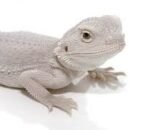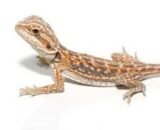Blue Bearded Dragons are a strikingly beautiful species with their unique blue coloration. They have a wide, triangular head with a distinct beard that is used for communication and intimidation. Their skin is covered in small, overlapping scales that are smooth to the touch.
Their body is elongated and slender, with a long, muscular tail that makes up about two-thirds of their total body length.
One of the most unique features of Blue Bearded Dragons is their blue coloration, which ranges from a pale blue-grey to a deeper shade of turquoise. Their bellies are typically lighter in color, ranging from white to cream. As they mature, their coloring may change slightly, with some individuals developing more vibrant hues of blue.
Personality and Temperament:
Blue Bearded Dragons are known for their gentle and docile personalities, making them a popular choice for families and first-time reptile owners. They are naturally curious and love to explore their surroundings, but are not as high-energy as some other reptile species.
These dragons are also quite intelligent and can become quite affectionate with their owners.
Check Out – Pastel Highway Ball Python, Baby Scaleless Head Ball Python
One of the most distinctive behaviors of Blue Bearded Dragons is their head-bobbing display, which is used by males to establish dominance and intimidate rivals. However, this behavior is not aggressive and is simply a natural part of their social hierarchy.
Blue Bearded Dragons are generally calm and gentle and are not known to be aggressive toward humans or other animals. Blue Bearded Dragons are known for their unique and captivating personalities.
They are gentle and friendly creatures that make excellent pets for families and reptile enthusiasts alike. These dragons are naturally curious and inquisitive and love to explore their surroundings. They are also quite intelligent and can become very attached to their owners, often seeking out attention and affection.
One of the most fascinating behaviors of Blue Bearded Dragons is their head-bobbing display, which is used by males to establish dominance and intimidate rivals. However, this behavior is not aggressive and is simply a natural part of their social hierarchy.
Blue Bearded Dragons are generally calm and gentle and are not known to be aggressive toward humans or other animals.
These dragons are also very adaptable and can thrive in a variety of environments. They are able to tolerate a wide range of temperatures and can adjust to different types of lighting and humidity levels. With proper care and attention, Blue Bearded Dragons can live for up to 15 years in captivity, making them a long-term commitment for those considering them as pets.
Check Out – Leopard Ball Python, Scaleless Head Ball Python
Overall, Blue Bearded Dragons are gentle, curious, and fascinating creatures that make wonderful pets. Their unique blue coloration and friendly personalities make them a popular choice for reptile enthusiasts of all ages. With proper care and attention, these dragons can thrive in captivity and provide their owners with years of joy and companionship.
Diet and Nutrition:
In the wild, Blue Bearded Dragons are omnivorous, which means they eat a mixture of plants and animals. In captivity, it’s important to provide a balanced diet that includes a variety of food types to ensure that your dragon receives all the nutrients it needs to thrive.
The primary component of a Blue Bearded Dragon’s diet should be live insects, such as crickets, mealworms, and roaches. These should be gut-loaded with nutrient-rich foods before feeding to your dragon. As your dragon grows, you can also include small amounts of pinkie mice, waxworms, and other live prey to provide a source of animal protein.
In addition to insects, Blue Bearded Dragons should also be fed a variety of leafy greens and vegetables. Some good options include collard greens, kale, dandelion greens, and butternut squash. It’s important to offer a variety of greens to ensure your dragon gets a range of nutrients.
Fruit should be offered sparingly, as it can be high in sugar. However, small amounts of chopped berries, apples, or mango can be offered as an occasional treat.
It’s important to provide a source of calcium and vitamin D3 for your Blue Bearded Dragon. Calcium can be provided by dusting your dragon’s food with a calcium powder, and vitamin D3 can be provided through UVB lighting. It’s important to ensure that your dragon’s lighting is properly set up to provide the right spectrum of light and heat.
Care Requirements:
Proper care and attention are essential for the health and well-being of Blue Bearded Dragons. These creatures require specific environmental conditions and a balanced diet to ensure they thrive in captivity. Here are some important care requirements to keep in mind when considering a Blue Bearded Dragon as a pet:
Housing: Blue Bearded Dragons require a spacious enclosure with plenty of room to move and climb. A tank with a minimum size of 40 gallons is recommended for juvenile dragons, and a larger enclosure will be needed as they grow. The enclosure should also have a basking spot with a heat lamp, a UVB light source, and a substrate that is easy to clean and maintain.
Temperature and Lighting: These dragons require specific temperature and lighting conditions to stay healthy. The basking spot should be kept at a temperature between 95-100°F, and the rest of the enclosure should be maintained at a temperature between 80-85°F during the day and 70-75°F at night. A UVB light source is also essential for providing the necessary Vitamin D3 for the dragon’s health.
Diet: Blue Bearded Dragons are omnivorous and require a varied diet of both insects and vegetables. Insects like crickets and mealworms can be offered as a staple, and vegetables like kale, collard greens, and squash should be offered as a supplement. It is also important to provide a calcium and vitamin supplement to ensure the dragon receives all the necessary nutrients.
Handling: Blue Bearded Dragons are generally calm and gentle, but they do require proper handling to prevent stress and injury. Always support the dragon’s body when picking it up, and avoid handling it for long periods of time.








Customer reviews
Reviews
There are no reviews yet.
Write a customer review